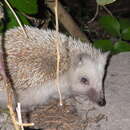en
names in breadcrumbs


Atelerix algirus is also known as the Algerian hedgehog.
Nothing is known about communication in the wild for Atelerix algirus. Hedgehogs raise their quills and make hissing noises when worried. In addition, hedgehogs often make purring noises when content. Like other mammals, scent cues are likely to be important in communication and in prey detection.
Communication Channels: acoustic
Perception Channels: visual ; tactile ; acoustic ; chemical
North African hedgehogs are classified as a species of least concern according to the IUCN Red List. Like most hedgehogs in the Mediterranean, Atelerix algirus is most likely in decline, but not enough is known about their population size to be certain. They are often killed by passing cars and populations are limited by suitable habitat. They are often killed by humans to be used for food, regional medical purposes, and ingredients in witchcraft markets.
US Federal List: no special status
CITES: no special status
North African hedgehogs have no known negative impact on humans.
North African hedgehogs often eat pest insects in gardens and populated areas. They are one of two species hybridized to create domesticated hedgehogs. Body parts are sometimes used in local medicinal practices and they are sometimes eaten as food.
Positive Impacts: pet trade ; food ; source of medicine or drug ; controls pest population
There is little information on the ecosystem roles of North African hedgehogs. They serves as prey for large predators that are able to get beyond their defensive spines and are likely to impact population levels of the species on which they prey.
North African hedgehogs are generalist omnivores. They forage at night for arthropods, small vertebrates, carrion, fungi, and other available foods.
Animal Foods: birds; mammals; amphibians; reptiles; eggs; carrion ; insects; terrestrial non-insect arthropods; mollusks; terrestrial worms
Plant Foods: seeds, grains, and nuts; fruit
Other Foods: fungus
Primary Diet: omnivore
North African hedgehogs are native to the northern regions of Africa from Morocco to Libya. They have also been introduced to nearby areas, including the southern, mountainous regions of Spain, France, and the islands off the coast of Africa, such as the Canary Islands and the Balearics. Introduced populations in France are now extinct.
Biogeographic Regions: palearctic (Introduced , Native )
North African hedgehogs prefer arid climates, but are found in a broad range of habitats including dry Mediterranean scrub, grasslands, pastures, cultivated fields, semi-desert, and gardens. They are also found near human populations. They are typically found at altitudes of 400 m or less, although elevations of up to 900 m have been observed in Morocco.
Range elevation: 0 to 900 m.
Habitat Regions: temperate ; terrestrial
Terrestrial Biomes: desert or dune ; savanna or grassland ; forest ; scrub forest
Little is known about the lifespan of Atelerix algirus. It is expected to follow trends seen in other hedgehogs of its size. If so, the expected lifespan would be between 3 and 7 years in the wild and 8 to 10 years in captivity.
North African hedgehogs range in length from 200 to 250 mm. They are paler in color than hedgehogs from Europe, with the possible exception of Erinaceus europaeus. The most useful diagnostic feature is the spine-free “part” on the crown of the head, which appears as a lack of a widow’s peak often seen in similar species. They also have larger ears, longer snouts, and longer legs than Erinaceus europaeus. The underbelly is colored either brown or white. The dorsal surface of Atelerix algirus is covered in sharp spines made of tough keratin.
Range length: 200 to 250 mm.
Other Physical Features: endothermic ; homoiothermic; bilateral symmetry
Eurasian eagle owls (Bubo bubo) overlaps in geographic range with Atelerix algirus and are known to prey on other species of hedgehogs. North African hedgehogs use their sharp spines to deter predators and are also cryptically colored.
Anti-predator Adaptations: cryptic
The breeding season for Atelerix algirus is October to March. They do not mate for life or engage in pair-bonding, but little else is known about mating behavior.
North African hedgehogs produce two litters per breeding season. Litter size is between 3 and 10 hoglets, and each hoglet weighs 12 to 20 grams. The hoglet is born blind, but gains vision quickly. The spines begin to erupt from underneath the skin and membranous coverings about 36 hours after birth. The gestation time for the species is 30 to 40 days and the young become sexually mature between 8 and 10 weeks of age.
Breeding interval: Atelerix algirus produces two litters per breeding season.
Breeding season: Breeding occurs from October to March.
Range number of offspring: 3 to 10.
Range gestation period: 30 to 40 days.
Range age at sexual or reproductive maturity (female): 8 to 10 weeks.
Range age at sexual or reproductive maturity (male): 8 to 10 weeks.
Key Reproductive Features: iteroparous ; gonochoric/gonochoristic/dioecious (sexes separate); sexual ; viviparous
Little is known about parental investment in North African hedgehogs. Like other mammals, however, females invest heavily in their offspring through gestation and lactation.
Parental Investment: female parental care ; pre-fertilization (Provisioning, Protecting: Female); pre-hatching/birth (Provisioning: Female, Protecting: Female); pre-weaning/fledging (Provisioning: Female)